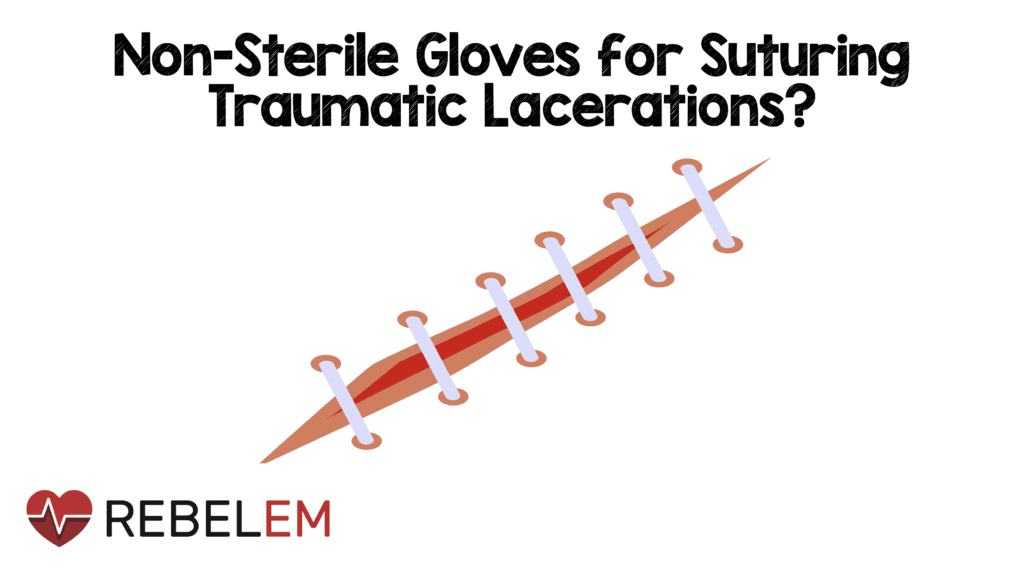
 Background: Traumatic lacerations presenting to the emergency department are, by definition, contaminated (ie non-sterile). Standard management involves irrigation, local anesthesia, closure and tetanus update if required. The existing literature has never shown benefit to sterile gloves in these types of injuries if we irrigate and clean the site appropriately. Not using a full sterile prep (ie drapes, sterile gloves etc) has the advantages of saving time, resources, and costs. But, would use of sterile drapes and gloves lead to a lower infection rate? There is almost no literature on this topic, with really only one ED study [2], with a small sample size showing no difference in infection rates between sterile versus non-sterile gloves in traumatic wound repair.
Background: Traumatic lacerations presenting to the emergency department are, by definition, contaminated (ie non-sterile). Standard management involves irrigation, local anesthesia, closure and tetanus update if required. The existing literature has never shown benefit to sterile gloves in these types of injuries if we irrigate and clean the site appropriately. Not using a full sterile prep (ie drapes, sterile gloves etc) has the advantages of saving time, resources, and costs. But, would use of sterile drapes and gloves lead to a lower infection rate? There is almost no literature on this topic, with really only one ED study [2], with a small sample size showing no difference in infection rates between sterile versus non-sterile gloves in traumatic wound repair.
Paper: Zwaans JJM et al. Non-Sterile Gloves and Dressing Versus Sterile Gloves, Dressings and Drapes for Suturing Traumatic Wounds in the Emergency Department: A Non-Inferiority Multicentre Randomised Controlled Trial. Emerg Med J 2022. PMID: 35882525 [Access on Read by QxMD]
Clinical Question: Is the use of non-sterile materials (gloves, dressings, and drapes) non-inferior to sterile materials in the rate of wound infection after suturing traumatic lacerations?
What They Did:
- Multicenter, single-blinded (clinician assessing wounds on follow up was blinded) randomized non-inferiority clinical trial
- Performed at 3 EDs in the Netherlands
- Compared:
- Non-Sterile Materials: Non-sterile gloves and dressings
- Sterile Materials: Sterile gloves, dressings, and drapes
- Non-inferiority margin was set at 2%
Outcomes:
-
Primary: Wound infection during follow up at 5 to 14d post-procedure (depending on wound location)
- Wound Infection = Abscess originating from the wound, cellulitis >10mm, purulent fluid, wound dehiscence was seen, and/or physician found wound treatment to be necessary at follow-up (i.e. antibiotic prescription)
Inclusion:
- Traumatic wound requiring treatment
- Agreeable to be included in study
Exclusion:
- No consent
- GCS <14
- Complicated wound
- Language barrier
- Not asked
- Time to presentation 24hrs
- Direct surgical intervention needed
- Signs of infection at presentation
Results:
- 2,468 eligible patients
- 1,480 patients were randomized
- Mean age of patients ≈40 years
- Wound characteristics:
- Most common location of wounds: Hands and Head/Neck
- Most wounds <7cm
- Most wounds had no visible contamination (≈85%)
- Most common time to treatment between 1 to 6hrs (≈75%)
- Most common wound preparation with water (≈84%)
-
Wound Infection Rate:
- Non-Sterile Group: 5.7%; 95% CI 4.0 to 7.5%
- Sterile Group: 6.8%; 95% CI 5.1 to 8.8%
- Mean Difference: -1.1%; 95% CI -3.7 to 1.5%
Strengths:
- Asks a clinically important question
- Multicenter, randomized clinical trial
- Baseline characteristics were similar between groups
- Consecutive enrollment, removing the potential of selection bias
- Follow-up evaluation of wound was performed by an attending EM physician blinded to treatment allocation
- Follow up information was obtained in 91% of randomized patients
Limitations:
- The power calculation required 2,140 patients needed to be included in the study, which unfortunately the study did not meet, meaning the study is underpowered
- Study discontinued early due to decline in patient recruitment
- >95% of patients were not diabetic, on immunosuppressants, or using chronic steroids, making difficult to draw conclusions in these patients
- Non-blinding of patient (likely not feasible to blind) may introduce bias in the follow up evaluation
- Non-blinding of the clinician may introduce bias (ie more extensive irrigation, more careful technique)
Discussion:
- As this is a non-inferiority study there has to be a benefit in using non-sterile materials (gloves, dressings, and drapes) compared to sterile materials in the treatment of traumatic lacerations. Some of those benefits include:
- Saves resources
- Saves costs
- Saves time
- In looking at characteristics of patients with or without wound infection, more infected wounds were located in the lower extremity (20.2% vs 12.2%) and patients using immunosuppressants (6% vs 1.5%)
Author Conclusion: “Although recruitment ceased prior to reaching our planned sample size, the findings suggest that there is unlikely to be a large difference between the non-sterile gloves and dressings for suturing of traumatic wounds and sterile gloves, dressings and drapes for suturing traumatic wounds in the ED.”
Clinical Take Home Point: Although underpowered, this trial suggests that there is no significant difference between non-sterile gloves/dressings compared to sterile gloves/dressings/drapes in the suturing of traumatic wounds and the risk of infection. Due to the small numbers of patients with diabetes mellitus, immunosuppressed and on corticosteroids, caution should be applied to extrapolating these results in those populations.
References:
- Zwaans JJM et al. Non-Sterile Gloves and Dressing Versus Sterile Gloves, Dressings and Drapes for Suturing Traumatic Wounds in the Emergency Department: A Non-Inferiority Multicentre Randomised Controlled Trial. Emerg Med J 2022. PMID: 35882525 [Access on Read by QxMD]
- Perelman VS et al. Sterile Versus Nonsterile Gloves for Repair of Uncomplicated Lacerations in the Emergency Department: A Randomized Controlled Trial. Ann Emerg Med 2004. PMID: 14985664
Post Peer Reviewed By: Anand Swaminathan, MD (Twitter: @EMSwami)
The post Non-Sterile Gloves for Suturing Traumatic Lacerations? appeared first on REBEL EM - Emergency Medicine Blog.
